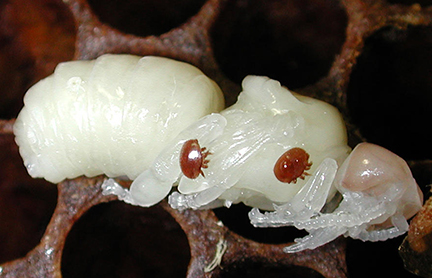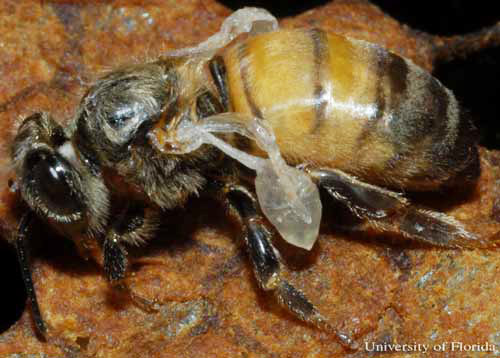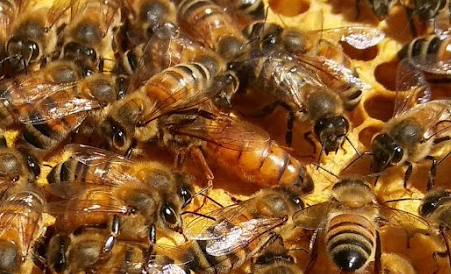If you have been around bees or beekeepers at all over the last few years, you have probably heard of the varroa mite. You cannot have a discussion about the challenges of keeping bees without mentioning that destructive ectoparasite; they are seemingly ubiquitous, biologically and physically virulent and constantly changing enough to develop resistances to treatments. With all of the problems that come with them and all of the different opinions on how to deal with them, I think we should arm ourselves with a deep and thorough knowledge of exactly what they are before we can make a truly educated decision on how to combat them.


HISTORY
Varroa Destructor evolved as a parasite of apis cerana (The Asian Honeybee) and only made its way to apis mellifera (The Western Honeybee) when European honey bees were shipped to eastern Russia or Asia sometime in the early 1900’s. Apis mellifera had no natural defense against this new pest and the havoc started early and spread rapidly once these infested European honey bee colonies were brought back to Europe by amateur beekeepers in the Russian Army. Through various methods of transfer (that we will cover later in the article) and an increasingly migratory nature to the business of beekeeping, the Varroa Mite spread across Europe and Africa, bringing with it destruction and disease. Despite efforts to quarantine the United States against this prolific parasite, in 1987 what was then mistakenly identified as varroa jacobsoni, was found in the states of Florida and Wisconsin.
Beekeepers in the United States and Canada were not prepared for the invasion and despite efforts to stop the spread and repair the damage, the varroa mite rapidly spread across North America.
CLASSIFICATION
Varroa destructor is an ectoparasite of the family Varroidae, genus Varroa. For years it was mistakenly identified as its genetically similar cousin, varroa jacobsoni. After genetic analysis, however, it was found that Varroa Destructor and Varroa Jacobsoni are different species and differ in 6.7% of gene sequences. (Biology and Control of Varroa Destructor, The Journal of Invertebrate Pathology)
(From now on I will refer to Varroa Destructor as mites, as they are the pests causing the problems and therefore the focus of the article.)
Adult female mites are a dark reddish brown, elliptical in shape and 1.0 – 1.80mm long and 1.50 – 2.0mm wide.
Adult male mites are smaller and yellowish in color, measuring .75 – 1mm long and .70 – .90mm wide.
Eggs are whitish in color and approximately .20mm long and .33mm wide. Eggs are difficult to see in the cell as they blend in with the larvae/jelly.
LIFE CYCLE
There are two distinct life cycles that adult female mites undergo: Phoretic and Reproductive. During the phoretic stage the mite feeds on the hemolyph of an adult bee, escaping the bees regular grooming by attaching between the segments of the bees abdomen. The phoretic stage usually lasts between 4 and 11 days, but during broodless periods, like winter, this stage may last multiple months. The longer a mite stays in phoretic stage the greater reproductive capabilities it has when it enters a brood cell to begin the reproductive stage.
The reproductive stage begins when the mite leaves the adult bee and enters a brood cell that is about ready to be capped by nurse bees. Drone brood cells are preferred by mites, due to the extra space and the longer period of development of the drone compared to either workers or queens. (Drone brood takes 24 days to hatch, compared to 21 for workers and between 16-18 for a queen. This preference of drone brood has led some beekeepers to practice drone brood removal, where a section or frame of drone brood is removed from the hive when all of the cells are capped) When the mite enters the brood cell it is then known as a foundress mite. The foundress mite first hides under the larvae breathing through the jelly using constructed tubes called peretrimes. After the brood food is consumed, the mite attaches itself to the larvae and starts feeding and shortly thereafter lays the first egg, an unfertilized egg that will develop into a male mite. The subsequent eggs are fertilized (female mites) and laid every 25 – 30 hours. Both sexes of mite will develop into adults between 6 and 7 days after the egg was laid. The amount of time it takes for eggs to develop into mites is crucial to the varroa mite’s success parasitizing apis mellifera, as the development from larvae is slower than that of apis cerana, allowing for more mites to hatch per reproductive period.
After molting into adult mites the mating begins. Unless more than one female mite entered the brood cell before being capped, male and female mites are forced to mate with siblings. The male mite’s mouth parts become hollow tubes that are then used to inseminate the females. The mated female mites will exit the cell after the bee hatches, starting their phoretic stage.
Studies have shown that when the adult female mite leaves the brood cell it prefers to attach to nurse bees over foragers and young bees versus old. Some think it has to do with the repellent nature of geraniol, a component of the Nasonov pheromone, others are of the idea that the nurse bees offer better nutrition for the mite.
EFFECTS
The effects of the varroa mite on apis mellifera are numerous and varied. There are direct effects that result from the feeding of mites on larvae and adult bees, and there are viral diseases transferred from mite to bee.
VIRUSES/DISEASES
There are numerous honey bee diseases and viruses that can threaten the health of a colony and a majority of those are either transmitted by mites or the bee’s natural immunities are weakened by the mite, allowing viruses and diseases to take hold and do more damage than it could without the assistance of the parasite.
Viruses are microscopic genetic packets, consisting of DNA or RNA wrapped in a sheath of proteins. Viral particles cannot multiply outside of a host and require some type of interaction between hosts to transfer. This is where the mite comes in. The varroa mite can act as both a biological and physical vector for transmitting viral diseases and usually infects the bee when feeding, injecting the viral packets directly into the bee’s circulatory system.
DEFORMED WING VIRUS


There are direct correlations between varroa mite levels and levels of DWV. In heavily infested colonies levels of bees infected with DWV can climb to 100%. The varroa mite acts as a biological and physical vector for transmitting this virus, meaning it can replicate the virus in itself as well as carry it on its surface from bee to bee. A 2013 study done by the Bee Informed Partnership showed that 80% of tested colonies had some levels of DWV.
Symptoms of DWV include deformed wings, shortened and/or misshapen abdomens, inability to fly and early death of pupae. DWV can result in death of the colony and is often mistaken for normal winter losses.
ACUTE BEE PARALYSIS VIRUS
Acute Bee Paralysis Virus is a common virus in honey bee colonies. The levels of viral particles that a hive can endure when transmitted from adult bee to larvae are high, therefore most infected colonies with low mite loads show no symptoms.
When ABPV is transmitted by mite, however, the bee’s threshold is lowered greatly due to the fact that the virus is injected directly into the bees circulatory system. Infected colonies with high mite loads will often die within one season.
KASHMIR BEE VIRUS
Like ABPV, Kashmir Bee Virus becomes mortally dangerous to a bee colony when transmitted directly to the circulatory system by mites. Without intervention, a colony infected with Kashmir Bee Virus by mites will die without showing any overt symptoms.
CBPV/SACBROOD/OTHERS
There are studies being done on more than 20 honey bee viruses and the varroa mite’s effect. Whether a disease can be transmitted by the mite, however, does not decide whether the disease is affected by the mite. General immune defense is weakened by the mite’s feeding and can often be the difference between a normally innocuous infection and colony collapse.
DIRECT EFFECTS OF MITE INFESTATION
Aside from the viruses and diseases that mites transfer, they have a direct impact on the bees they parasitize. Depending on how many foundress mites enter a brood cell, the larvae may die or be born significantly underweight. The underweight bee will have poorer flight performance and a shorter lifespan. Bees parasitized as adults can have physical and physiological problems, sometimes showing a lack of ability to navigate back to the hive.
Another aspect to mite infestation that causes eventual colony collapse is the timing of their population peak. Since bee and mite levels, if left untreated, increase throughout the year, the timing of the varroa mite’s population growth causes particular problems to the beekeeper attempting to overwinter. As the summer’s end nears, the queen starts to slow her egg laying, gradually reducing the size of the brood nest. This reduces the hive’s population just as the mites are reaching their peak population for the year. As the last of the winter bees hatch, the mites emerge as well, causing the year’s highest ratio of mite:bee just as the bees are entering the already perilous winter. This causes many beekeepers to question their overwintering strategies, blaming the cold or moisture for a collapse that was mainly caused by the aptly named varroa destructor.
DISTRIBUTION METHODS
Mites can move from bee to bee and hive to hive in numerous ways, many of which are exacerbated by human intervention. A phoretic mite can transfer from one bee to another in times of interaction, i.e. on a flower, during robbing, drifting and during swarms. Foundress mites and eggs can be transferred to new hives when a beekeeper takes brood from a strong hive in an attempt to strengthen another, or when equipment is reused on another hive.
Mites can transfer from region to region through swarming, absconding, robbing or through a beekeeper transporting hives.
TREATMENTS/MANAGEMENT METHODS
Beekeepers have developed many methods of managing varroa levels, including acaricides, acids, essential oils and management techniques. The only thing I preach when it comes to varroa mites is to breed selectively. Whether you choose to treat with oxalic acid or apistan, small cell bees or brood breaks, the thing you can do to help the overall picture is to select the bees in your yard that deal with varroa mites the best, the ones that need the least assistance, and propagate from them. When varroa mites were introduced in 1987 many experts thought the feral colonies would perish quickly and completely. They didn’t. We have the ability as a collective group to breed the varroa into insignificance. We aren’t all Purdue University but that doesn’t mean we can’t be an agent of change.
Keeping a tally of mite numbers in your hive can be essential to finding the queens worthy of propagation. Relying on visual inspection for this can lead you to a “too little too late” scenario, for more accurate numbers that give you the opportunity to manage accordingly, you are left with methods like the sugar shake, alcohol wash and sticky board. They all have varying levels of accuracy and damage inflicted to the hive. I won’t describe those methods in this article, for now a good place to look for a detailed description of these methods is http://scientificbeekeeping.com/sick-bees-part-11-mite-monitoring-methods/
Summary
I did not mean this to scare you away from beekeeping, or to persuade you at the end of the article to follow my methods of varroa management, only to inform you of the honey bee’s singularly most dangerous foe. My feelings on the treatment debate are not yet fully formed, I like to consider myself a realist but in reality, at heart, I am an idealist. I think the natural course of things will lead us to a better bee and beekeepers will be the recipient of the rewards that follow this trying and difficult period. As I say on my Youtube channel, get out, and have fun with your bees.
References :
University Of Florida Entomology and Nematology Department
Varroa Mite Reproductive Biology by Zachary Huang
Varroa Mite Spread in the United States by Andrew Wenner


Good article. Thanks for the info! I’ve been keeping bees for 5 years. Currently have 13 hives. I utilize drone brood removal and screened bottom boards, but do not use chemical treatments for mites.
My 12 yr old daughter and I enjoy your YouTube channel. The random inspection Fridays have been a good addition to your videos. Keep up the good work.